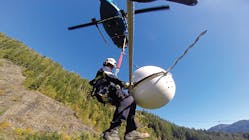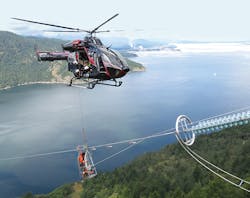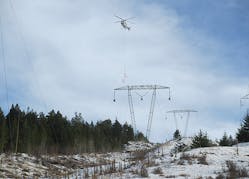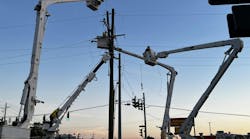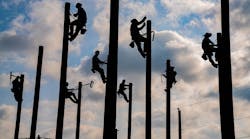On the west coast of Canada, BC Hydro maintains a significant portion of its transmission and distribution system in mountainous terrain with limited conventional vehicle access. Consequently, the utility has relied on helicopters for decades to construct, maintain and repair its system. Between contractors performing work on its system and its own operations, BC Hydro has spent more than $100 million on helicopter services over the past three years.
In 2008, following a series of serious near-miss incidents over the preceding 24 months, the large integrated utility performed a risk assessment covering its helicopter operations. Tragically, in September of that year, BC Hydro experienced a helicopter accident before the findings of the risk assessment could be integrated into its operations. After the helicopter accident, BC Hydro carried out a comprehensive review of its aviation operations and completely restructured the processes by which these operations are managed.
Investigating the Crash
Two power line technicians were patrolling a 60-kV transmission line from a Bell 206 helicopter. The helicopter was flying low and slow to facilitate the line patrol when a loss of power to the rotors occurred. It is believed the pilot attempted an autorotation, but either the helicopter was flying too low and slow for this maneuver to be successful or a small distribution line was encountered that forced the pilot to flare the machine early, or both.
The crash claimed the lives of the pilot, two linemen and a pedestrian on the ground. While the investigation did not determine conclusively the cause of the loss of power to the rotors, a disruption of fuel delivery to the engine was assigned as the most likely cause.
After a comprehensive review of its aviation operations, BC Hydro completely restructured the processes by which these operations are managed. Following are key aspects of the utility’s current operations:
• An internal aircraft operations department that oversees the day-to-day aviation operations
• A rigorous prequalification process for potential helicopter service providers, including hours of service and task-specific experience for pilots
• Limitations on the number of service providers (BC Hydro does not operate its own helicopter fleet)
• Mandatory periodic audits of the service providers and their safety management systems
• Mandatory training for all personnel who fly in or work from helicopters, including crew resource management training
• Standard operating procedures for all work that involves helicopters
• Requirements for using specific types of helicopters for specific missions.
Conducting a Risk Analysis
As BC Hydro entered the current decade, the utility was in the process of planning large maintenance and construction projects, including the construction of two transmission circuits and a spacer damper replacement program. This work would involve thousands of flights to place linemen in proximity to and on towers, and to deliver them to work positions for the replacement of spacer dampers.
BC Hydro sought guidance to identify the optimal approach for accomplishing these tasks, one that would strike the right balance between safety, efficiency and cost. The utility performed a risk analysis that focused exclusively on structure and conductor access methods.
Naturally, conventional structure and conductor access methods (vehicle, climbing or carts) were concluded to be safer than helicopter access methods, but it was evident these conventional methods were not viable in many cases because of the terrain challenges. Helicopter access methods were needed. The following helicopter access methods were reviewed and examined:
• Class D, where the worker is suspended from a long-line external to the machine and delivered to the work position from this suspended position
• Hoist access, where the worker flies to the work site inside the machine and is lowered to the work position on a winch line operated by a hoist technician
• Platform access, where the worker sits on a platform mounted to the side of the helicopter.
For the purpose of delivering linemen to the top of transmission towers, helicopter touch-and-go methods, which have been used at BC Hydro for decades, also were examined. Touch-and-go access places the helicopter’s skids in contact with the top of the tower with only a fraction of the machine’s weight bearing on the steel lattice while workers exit or enter the helicopter.
Access methods that maintain the greatest distance between the rotors and the wires or structure clearly involve less risk than those that do not, because they are forgiving of disturbances that could cause the helicopter to lose minor amounts of elevation; in mountainous terrain, such disturbances can be caused simply by a gust of wind. From this perspective, the Class D and hoist-access methods are superior to the others.
In addition, they have the benefits of being able to deliver the lineman to the work position regardless of the wind direction. Because the lineman generally spends less time suspended from the helicopter with hoist access, relative to the Class D long-line insertion methods, the hoist-access method was rated as having the least risk.
Finding the Right Helicopter
One of the many changes to BC Hydro’s aviation operations was the introduction of requirements for using specific types of helicopters for specific missions. One key feature of these requirements is the need to have adequate power reserve. For example, planned operations will not demand more than 90% rated horsepower, so there is always 10% in reserve if needed. A second feature is the requirement for twin-engine machines when work is performed using work methods that would result in a single-engine machine flying inside its height-velocity curve. Finally, each flight requires approval of the aviation operations department, which evaluates each proposed flight by scoring it against a multi-criteria risk-evaluation tool that considers pilot experience, weather and helicopter suitability. Missions that score too high on this risk-evaluation tool are not approved.
Helicopters can land safely — terrain permitting — in the event of a loss of power to the rotors, provided the machine has sufficient forward velocity and elevation aboveground. Operating inside the height-velocity curve means the helicopter is flying too low or too slow to be able to land safely in the event of a loss of power to the rotors. Consequently, twin-engine machines are now commonly used in BC Hydro’s operations, including for construction, maintenance, structure access and rescue.
When the utility initially put in place its requirement for twin-engine machines, it experienced some growing pains as its demand for this class of helicopter at times exceeded local supply. Furthermore, the utility learned not all twin-engine helicopters are alike. Given the nature of the hazard the utility was trying to address, it needed machines capable of hovering out of ground effect with one engine inoperative (HOGE OEI).
Supply soon rose to meet demand. Today, BC Hydro’s helicopter service providers have enough modern twin-engine machines to meet the utility’s needs. An unanticipated benefit is these expensive helicopters tend to be operated only by the best pilots.
Presently, the touch-and-go Class D long-line and hoist-access methods use twin-engine helicopters to deliver linemen to work positions on the BC Hydro system, with the latter two also being used for rescue.
In 2010, one of the utility’s service providers — Ascent Helicopters — presented BC Hydro with the option of using a hoist-equipped MD-902 for work on the transmission system. This helicopter has two PW207E engines as well as excellent HOGE OEI performance.
The small compact size of this machine and absence of a tail rotor make it ideal for hoisting operations. The hoist is made up of a two-speed electric motor and a 3/16-inch steel cable with a safe working load of 600 lb. It operates at low speed (150 ft/minute) for loads in excess of 300 lb; and it can operate at low or high speed (275 ft/minute) for loads under 300 lb. Strict federally regulated maintenance and inspection requirements ensure the hoist is capable of safely performing its intended function each and every time.
Using Hoisting Methods
BC Hydro first used hoisting methods in 2011 to repair a conductor that spanned an ocean channel. While hoisting methods have been used by the military and other various government agencies (for example, in fighting forest fires) for many years, this job was thought to be the first civilian application of helicopter hoisting methods in Canada. Since the initial hoisting job, BC Hydro has learned a lot about the many benefits, the challenges and some of the drawbacks associated with helicopter hoisting methods.
For example, the utility discovered it could place flags strategically in or near the work zone to assist the pilot with establishing a vertical reference; without the use of flags, establishing a vertical reference was very challenging, especially when working over water. Another factor the utility needed to adjust to was the surprisingly large movement of conductors as a result of rotor wash.
Additional benefits of hoisting are it eliminates the need to use riskier methods such as Touch and Go for placing workers on towers, and it can improve the efficiency of work. For example, it allows for the insertion of multiple workers at a time without the need to return to the fly yard as per long-line methods. In addition, it facilitates the quick removal of workers from a structure or bundle in response to a sudden change in weather, which is not uncommon in mountainous terrain. Furthermore, it allows for on-site immediate rescue, and it has been found to minimize worker fatigue.
The drawbacks include cost, because suitable machines are not inexpensive. Also, the harnesses are considered to be components of the hoist and are accordingly federally regulated. Linemen cannot use their personal harnesses but instead must use the harness that comes with the helicopter and hoist. Presently, there are still few helicopter hoist service providers. Furthermore, depending on the application, there are times when the helicopter is briefly attached via the hoist line to a tower, although this is mitigated by the hoist tech and the pilot both having independent means to sever the hoist line.
One unique drawback originates from the numerous benefits associated with hoisting methods: some experienced workers view hoisting as being far superior to BC Hydro’s earlier helicopter work methods. As such, a degree of complacency — which is unwarranted for any helicopter operation — has at times appeared in their work habits.
Working in Remote Areas
Today hoisting is used for a variety of work on the BC Hydro system, including hoisting to ground (that is, placing workers at a work site practically inaccessible by other methods); hoisting to structures; hoisting to unstable plant (for example, for performing repairs mid-span on conductor unfit for supporting a cart); hoisting for bare-hand access; and rescue. Extensive annual training for all workers involved, including the pilot and hoist technician, is required under federal aviation regulations.
Recently, BC Hydro used hoisting methods to remove several spans of decommissioned wood structures and conductors from an environmentally and socially sensitive location for which conventional vehicle access was not physically possible. To complicate matters, the poles were too rotten to climb, and they could not be felled because of the risk of breaking insulators in an area from which damaged porcelain could not be left or realistically be retrieved.
By hoisting ground workers to the site, BC Hydro was able to complete this job. A worker suspended from the hoist installed a long sling to the top of each pole. The conductors then were cut from the helicopter using a proprietary tool fitted to the end of the hoist line. With the conductors cut at about mid-span, the cutter was removed from the hoist line and the ground worker connected the hoist to the (long) sling.
With a slight amount of tension applied to the hoist line, the guy wires all were cut, and then the pole was cut at ground level with a chainsaw. The pole, crossarms, insulators and half span of conductor on either side of the pole all were flown together and laid down in a remote fly yard. Arguably, this job would not have been successful without the use of hoisting methods.
Reducing Risk
Performing work from a helicopter adds an additional dimension to the risks linemen who work on the power system already face. BC Hydro has learned many of the risks associated with utility helicopter operations can be mitigated by robust aviation management practices.
The utility’s efforts at reducing risk to date have been kindly recognized by the industry. In 2014, BC Hydro was the recipient of the BC Aviation Safety Council Silver Wings Safety Award; in 2015, BC Hydro was awarded the Airbus Helicopters Canada Innovation in Safety Award.
Perhaps, though, the most significant recognition comes from BC Hydro’s own workers. They view the safety improvements to the helicopter operations as a meaningful tribute to the two linemen who lost their lives in the tragic 2008 helicopter accident. Still, BC Hydro is well aware these risks will never be eliminated, and it continues to be vigilant and search for opportunities to further reduce risk.
Acknowledgement
This article is dedicated to the memory of Rob Lehmann and Dirk Rozenboom.
Geoff Nielsen is a work methods specialist engineer for BC Hydro and a professional engineer.
Ryan Monk is a trades training instructor for BC Hydro.


